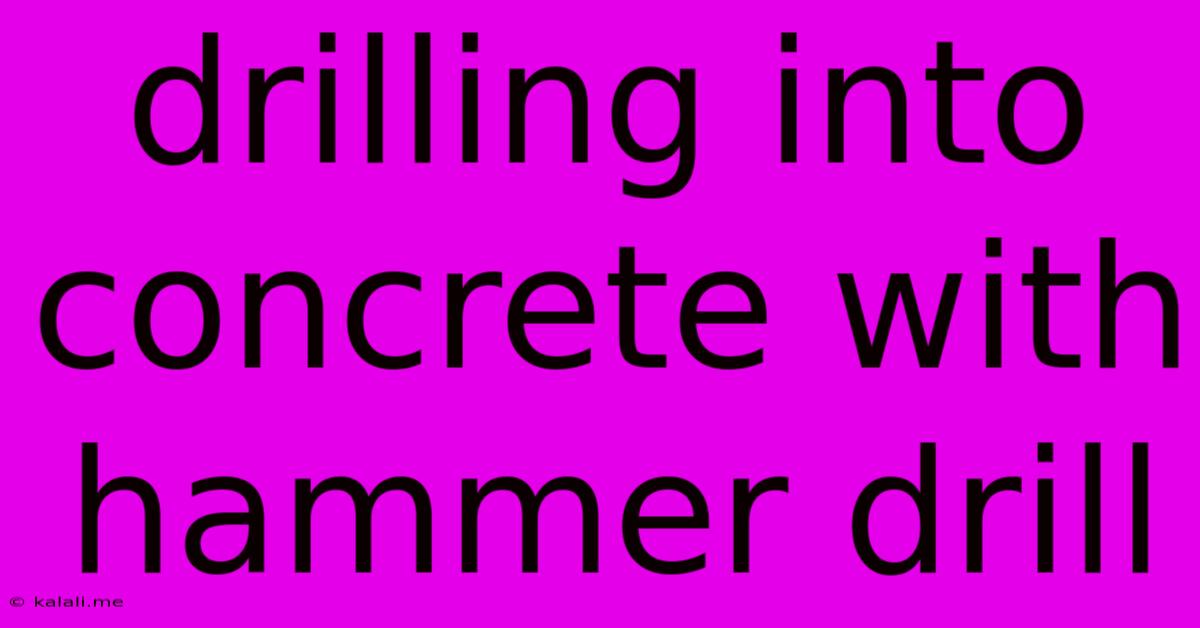Drilling Into Concrete With Hammer Drill
Kalali
May 25, 2025 · 3 min read

Table of Contents
Drilling into Concrete with a Hammer Drill: A Comprehensive Guide
Drilling into concrete can be a daunting task, but with the right tool and technique, it becomes significantly easier. A hammer drill is specifically designed for this purpose, offering superior power and efficiency compared to standard drills. This guide provides a comprehensive overview of drilling into concrete with a hammer drill, covering everything from choosing the right bit to achieving a clean, precise hole.
What is a Hammer Drill and Why is it Best for Concrete?
A hammer drill is a power tool that combines the rotational action of a standard drill with a powerful hammering mechanism. This dual action is crucial for breaking through the hard, dense material of concrete. Unlike standard drills that rely solely on rotation, the hammering action of a hammer drill shatters the concrete, making the drilling process significantly faster and more efficient. This makes it ideal for a variety of concrete drilling tasks, from anchoring shelves to installing large fixtures. It's a significant upgrade from using a standard drill, which would likely struggle and potentially damage the bit.
Choosing the Right Drill Bit
Selecting the appropriate drill bit is paramount for success. Incorrect bit selection can lead to broken bits, damaged equipment, and ultimately, a frustrating experience. Here’s what you need to consider:
-
Material: Ensure your drill bit is specifically designed for concrete. Carbide-tipped masonry bits are the most common and effective choice. These bits feature durable carbide tips that can withstand the harsh conditions of drilling into concrete. Avoid using standard high-speed steel (HSS) bits, as they are not designed for this purpose and will quickly dull or break.
-
Size: Choose a bit size appropriate for your application. Measure the diameter of the fasteners or anchors you will be using to determine the necessary hole size. Remember to account for any tolerance required for a snug fit.
-
Length: Select a bit long enough to penetrate the concrete's depth. Longer bits are necessary for thicker concrete slabs or walls.
Preparing for Drilling
Before you begin drilling, take the necessary precautions to ensure safety and efficiency:
-
Safety Gear: Wear safety glasses to protect your eyes from flying debris. Consider a dust mask, especially for larger projects, to prevent inhaling concrete dust. Hearing protection is also recommended due to the loud nature of the hammer drill.
-
Mark the Drilling Location: Precisely mark the location where you intend to drill. Use a pencil or marker to create a clear indicator. This will help prevent accidental drilling in the wrong spot.
-
Secure the Workpiece: If possible, secure the concrete surface you are drilling into to prevent movement and ensure accuracy. Clamps or other securing devices can be extremely helpful.
Drilling Technique
Now, let's move onto the actual drilling process:
-
Start Slow: Begin drilling at a low speed, gradually increasing the speed as the bit penetrates the concrete. Starting slowly helps prevent the bit from walking or slipping.
-
Apply Steady Pressure: Maintain consistent, even pressure on the drill. Avoid excessive force, as this can damage the bit or the drill.
-
Use Lubricant (Optional): Some users find that using a lubricant, such as water or cutting fluid, helps to cool the bit and reduce dust. However, this is not always necessary, especially for smaller drilling jobs.
-
Take Breaks: For large or deep holes, take regular breaks to allow the drill and bit to cool down. Overheating can dull the bit and damage the drill.
Troubleshooting Common Issues
Even with proper technique, you might encounter some problems:
-
Bit Walking: If the bit wanders from the intended drilling location, use a center punch to create a small indentation at the desired location. This will provide a better starting point for the bit.
-
Broken Bit: This usually indicates improper use or a worn-out bit. Replace the bit immediately.
-
Slow Drilling: This could indicate a dull bit or an overly aggressive drilling approach. Replace the dull bit or try lowering the speed.
By following these steps and tips, you can successfully drill into concrete using a hammer drill, completing your projects efficiently and safely. Remember, safety should always be your top priority.
Latest Posts
Latest Posts
-
Chomping At The Bit Or Champing At The Bit
May 25, 2025
-
What Is The Ph Of Lime
May 25, 2025
-
Projection Of A Point Onto A Line
May 25, 2025
-
When To Use Degrees Or Radians
May 25, 2025
-
How To Open A Drawer That Is Stuck
May 25, 2025
Related Post
Thank you for visiting our website which covers about Drilling Into Concrete With Hammer Drill . We hope the information provided has been useful to you. Feel free to contact us if you have any questions or need further assistance. See you next time and don't miss to bookmark.